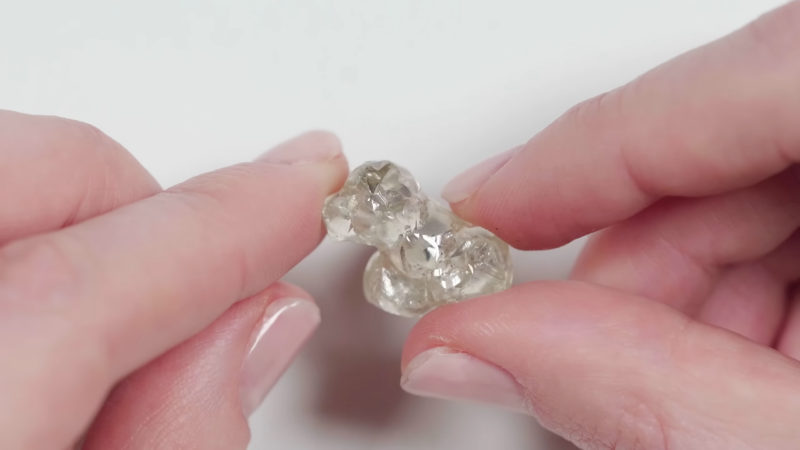If you thought that all diamonds are the same, you were wrong, my friend. Raw diamonds are not like the shiny, polished gems in jewelry stores. They are uncut and natural, looking more like ordinary rocks.
This guide is straightforward to follow, helping you learn the basics of spotting a raw diamond. It’s great for anyone curious about these rocks or looking to learn something new. Let’s explore how to recognize these hidden gems in their natural state!
Key Features
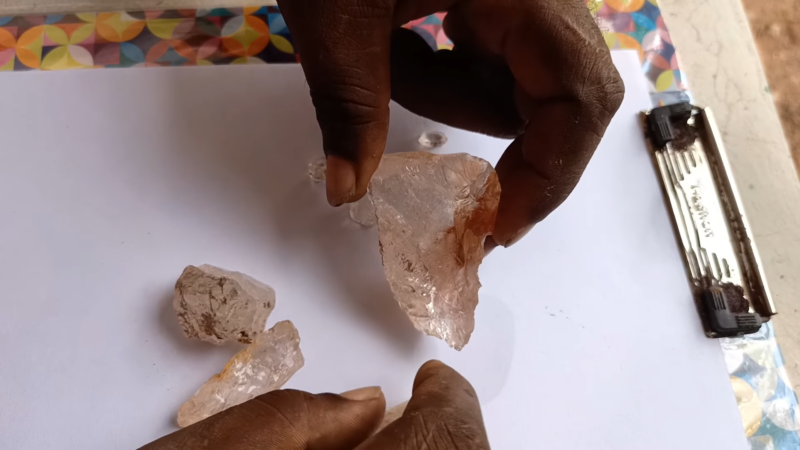
Raw diamonds, or rough diamonds, are nature’s gift, formed under the intense conditions of high pressure and temperature in the Earth’s mantle. Unlike cut and polished ones, raw diamonds are unaltered by human hands and retain their natural form as they were when ejected to the surface through volcanic activity.
These gems, often appearing dull and lacking the brilliance of polished diamonds, are diamonds in their most authentic and unrefined state. They are distinguished by several key characteristics:
Hardness: Diamonds, being the hardest known natural substances, stand out due to their ability to scratch any other mineral, including other diamonds. This remarkable hardness is a crucial identifier, as it differentiates them from look-alike minerals that might be softer.
Luster: Unlike other minerals that might have a metallic or glassy sheen, raw diamonds exhibit a unique greasy or waxy luster. This characteristic luster is a result of their unique molecular structure, setting them apart from other gemstones.
Shape: Raw diamonds commonly take shapes like octahedrals (resembling two pyramids attached at the base), dodecahedrals (with twelve flat surfaces), and cubes. These shapes are indicative of the natural crystalline structure of diamonds, formed deep within the Earth.
Color: Contrary to popular belief, raw diamonds come in a spectrum of colors. Most of them are not pristine clear-of-cut gems but can range from yellowish or brownish hues to rarer colors like blue, green, or pink. This variety in color is due to the presence of different impurities within the diamond structure.
Common Misconceptions
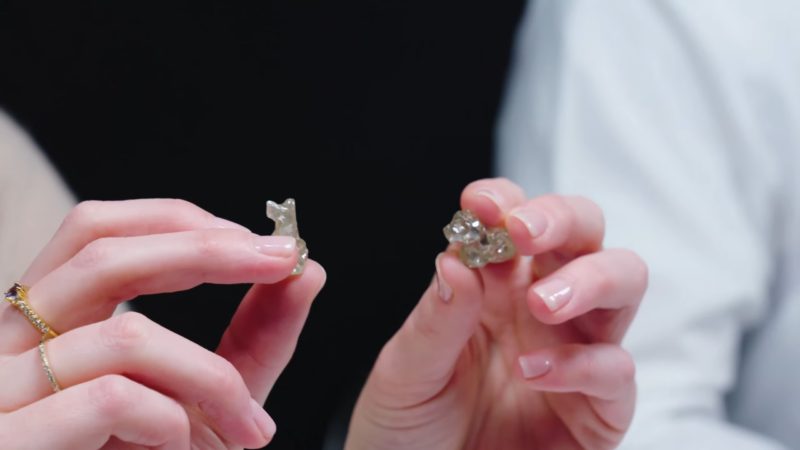
Several misconceptions exist about raw diamonds, which can mislead:
All Raw Diamonds are Clear and Colorless
This is a widespread myth. In reality, raw diamonds exhibit a variety of colors, and the clear, colorless ones are actually quite rare.
They are Always Shiny
Another common misconception is that raw diamonds are always shiny. In truth, they often have a dull, greasy appearance, making them harder to identify compared to their polished counterparts.
Size and Shape Consistency
People often believe that all diamonds, including raw ones, have a consistent size and shape. However, these can vary greatly in both, appearing in different forms and sizes, ranging from small pebbles to larger, more irregular shapes.
The Identification Process
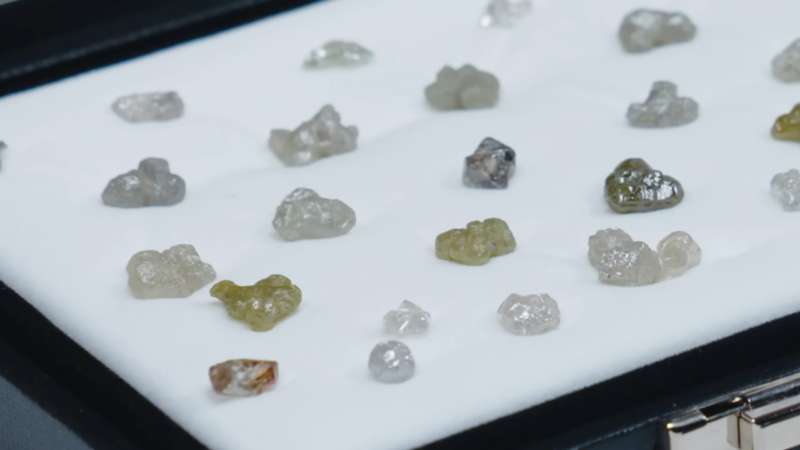
Initial Examination
A preliminary visual inspection is key:
- Crystal Form: The distinctive crystal structure of diamonds, often in forms like octahedral, is a prime identifier. A keen eye can distinguish these forms, which are indicative of the diamond’s natural growth process.
- Greasy Luster: This unique feature of diamonds, a sort of greasy sheen as opposed to a shiny or metallic luster, can help differentiate them from other minerals.
- Rounded Edges: Unlike glass and other minerals that can have sharp, jagged edges, diamonds typically have rounded edges due to their crystal structure and natural erosion processes.
Advanced Testing
For conclusive identification, several tests can be performed:
| Identification Method | Description |
|---|---|
| Hardness Test | Utilizes a hardness testing kit to check if the stone can scratch glass or other hard substances, leveraging the unmatched hardness of diamonds. |
| Specific Gravity Test | Employs specialized equipment to determine the density of the stone and compares it to the known specific gravity value of diamonds, which is 3.52. |
| Professional Appraisal | When uncertain, seeking the opinion of a gemologist or a qualified professional in the field is recommended. They can provide a definitive identification and offer additional insights about the diamond. |
Where to Find Them?
Raw diamonds are found in specific geological settings:
- Cratonic Regions: These stable parts of the Earth’s crust, such as those in Africa and Eurasia, are prime locations for diamond deposits. The age and stability of these regions make them ideal for diamond formation and preservation.
- Alluvial Deposits: Diamonds, due to their hard nature, can be eroded from their primary location and carried to rivers and streams. These alluvial deposits are often rich sources of diamonds, as the gems get concentrated in these areas over time.
- Kimberlite Pipes: These volcanic pipes are primary sources of diamonds. Named after the town of Kimberley in South Africa, these pipes are formed by deep-source volcanic eruptions that bring diamonds to the surface.
Tools and Equipment
Proper tools can aid significantly in the search for raw diamonds:
Shovels and Sieves: Essential for digging through soil and sifting through sediment, these tools help in uncovering potential diamond-bearing rocks or gravel.
Magnifying Glass: This simple tool is crucial for closely inspecting rocks and minerals. It helps in identifying the specific characteristics of diamonds, such as crystal structure and luster.
Hardness Testing Kit: Given the unmatched hardness of diamonds, a kit to test mineral hardness can be a reliable way to differentiate them from other stones. A diamond will scratch every other material, including hardened steel and corundum.
Legal Considerations
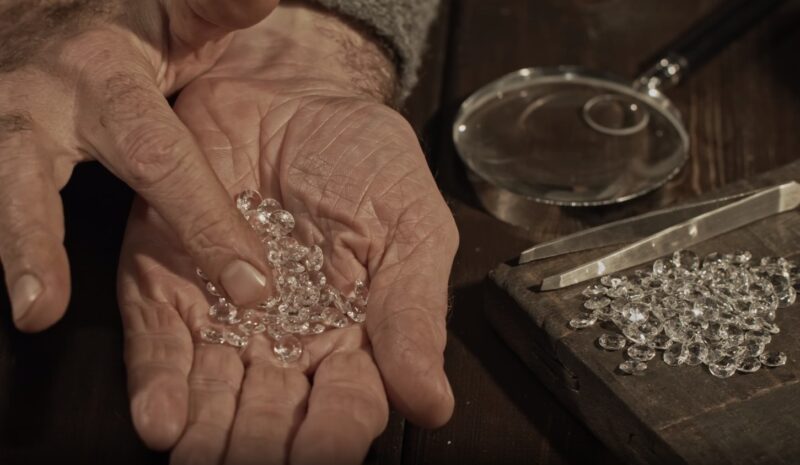
The legal framework surrounding diamond searching is important:
- Always secure permission on private land before searching on private property. This respect for property rights is essential to avoid legal issues.
- In regions rich in diamonds, there are often specific laws and regulations governing the mining and collection of these stones. It’s important to be aware of and adhere to these regulations.
- In some jurisdictions, finds of significant value, like diamonds, must be reported to authorities. Understanding these requirements is crucial to ensure that your diamond hunting is within legal boundaries.
FAQs
Can raw diamonds be identified by their weight in comparison to other stones of similar size?
Yes, diamonds have a specific gravity of 3.52, making them denser and therefore heavier than many look-alike stones of similar size. A simple water displacement test can help compare the density of your stone to that of a diamond.
Are there any specific geographical regions where I am more likely to find raw diamonds?
Besides cratonic regions and alluvial deposits, countries like Canada, Russia, Australia, and Brazil are also known for their diamond mines. In Canada, for example, areas like the Northwest Territories are renowned for diamond deposits. However, the likelihood of finding these stones greatly depends on the geological history of the region.
How does the fluorescence of a diamond help in its identification?
Many diamonds, when exposed to ultraviolet (UV) light, exhibit fluorescence – they emit a visible light, often a blue glow. This characteristic can be a useful identification tool, as not all minerals will fluoresce under UV light.
However, not all of them show fluorescence, so its absence does not necessarily mean the stone is not a diamond.
What is the impact of weathering on the appearance of a raw diamond?
Over time, raw diamonds exposed to weathering can lose their greasy luster and might appear more frosted. This weathering can slightly alter their appearance, making them look less shiny and more like ordinary pebbles, which can be misleading during the identification process.
Can I use a smartphone app to help identify a raw diamond?
While there are smartphone apps designed to assist in identifying gemstones, they are generally not reliable for accurately identifying raw diamonds. These apps may provide some basic guidelines or comparisons, but they lack the precision of professional tools and assessments.
It’s always best to consult a professional for definitive identification.
How does temperature affect a raw diamond during identification?
Diamonds are excellent conductors of heat. A simple test is to breathe on the stone like you would on a mirror. A diamond will disperse the heat rapidly and clear up almost instantly, while other minerals will remain fogged for a longer period.
This test, however, is not foolproof and should be used in conjunction with other identification methods.
Summary
In conclusion, identifying a raw diamond is a process that requires careful examination and knowledge of specific characteristics. Methods such as the hardness test, specific gravity test, and seeking professional appraisal can aid in distinguishing genuine diamonds from other minerals or gemstones.
Remember that while these techniques can provide valuable insights, a definitive identification should ideally be confirmed by a trained gemologist or an expert in the field. With the right tools and expertise, anyone can gain the skills needed to recognize the brilliance of a raw diamond hidden within its rough exterior.
